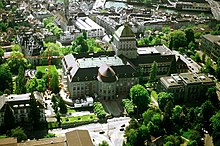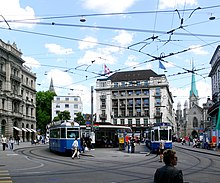Altstadt (Zürich)
Altstadt
Kreis 1 District 1 | |
|---|---|
District | |
|
City |
The Altstadt (German for "old town") in the Swiss city of Zürich encompasses the area of the entire historical city before 1893, before the incorporation of what are now districts 2 to 12 into the municipality, over the period 1893 to 1934. Die Altstadt approximately corresponds to the area enclosed by the former city ramparts, and is today within the administrative area of the city called Kreis 1 (District 1).
With a population of 5,617 (as of 2015), it houses about 1.4% of the city's total population.
Administratively, District 1 is divided into four parts or quarters by the


Lindenhof

Der Lindenhof ("The lime trees courtyard") quarter corresponds to the mindere Stadt, the smaller but more prestigious half of the medieval town left of the river. This is the oldest core of the city, with settlement traces dating to pre-Roman (
The
The
Zunfthaus zur Meisen at Münsterhof plaza near Fraumünster church houses the porcelain and faience collection of the Swiss National Museum. Lindenhof also contains the former Augustinian abbey, and formerly the Oetenbach nunnery north of the Lindenhof hill, demolished in 1903 to make way for the Uraniastrasse as part the partially built «Urania-axis» Sihlporte–Uraniastrasse–Zähringerplatz by Gustav Gull, and the Urania Sternwarte.
Fraumünster
The
Rathaus




The Rathaus quarter is named for the town hall, built in the 1690s. It is the part of the medieval town on the right side of the Limmat, separated by the Hirschengraben from the
Limmatquai
The
- Bürkliplatz,
- Münsterbrücke between Grossmünster and Fraumünster,
- Rathausbrücke just north of the town hall,
- Rudolf-Brun-Brücke, between Mühlegasse and Uraniastrasse,
- the Mühlesteg footbridge
- Bahnhofbrücke, between Central and Zürich Hauptbahnhof.
north of Limmatquai:
- Walche-Brücke
- the Platzspitz
Niederdorf
The Niederdorf (lit.: "low village") was the least developed part of the medieval city. It properly includes just the north-eastern corner, between Mühlegasse and Central, but the term was extended to the whole part of the mehrere Stadt north of the town hall, i.e. for the entire length of the Niederdorfstrasse, or even including the parts north of the Kirchgasse.[citation needed]
So defined,[clarification needed] the Niederdorf includes Rindermarkt and Neumarkt, Froschaugasse and the area of the medieval Jewish quarter, the Predigerkirche (the former Blackfriars' monastery) at Zähringerplatz (historically the city hospital, now housing the city library) and the Zähringerstrasse.
Münstergasse
The mehrere Stadt between the Niederdorf and the Oberdorf (between Rathaus and Kirchgasse) includes the Münstergasse, Obere Zäune, Untere Zäune and the Barfüsserkloster (the former Franciscan abbey) as well as a number of alleys leaving Münstergasse: Marktgasse, Spiegelgasse, Krebsgasse, Ankengasse, Römergasse and Kirchgasse.[citation needed]
Grossmünster
Predigerkirche
Initially the church of the Predigerkloster (Dominican monastery), it became after the Reformation in Switzerland the parish church of Niederdorf respectively Neumarkt, and owns since 1900 the tallest church tower of Zürich.[3]
Oberdorf
The Oberdorf (lit.: "upper village") proper is the mehrere Stadt south of the Grossmünster, along the Oberdorfstrasse, between Kirchgasse and Rämistrasse.
Hochschulen



Hochschulen (universities) is wedged between Hirschengraben (the historical course of the eastern moat) and Rämistrasse, corresponding to the area taken up by the eastern fortifications of the 17th century
) to the south.Hochschulen in its southern end also includes the
Central
The Central square at the northern border between Rathaus and Hochschulen quarters is a major junction of the
Pfauen
Situated at Heimplatz, vernacularly called the Pfauen, are the theatre Schauspielhaus Zürich and the art museum Kunsthaus Zürich.
Bellevue
The
Stadelhofen
South of Bellevue are the squares
City
City is the area west of the
Platzspitz

Platzspitz (formerly Platzpromenade, Limmatspitz) is a park at the confluence of the two rivers of Zürich; the Limmat and the Sihl.
In medieval times, the area situated north of the city was used as pasture. In the early 15th century it was made into a shooting-range, and in the 16th to 17th centuries, Schützenfeste were held there. A remnant of these can be found in the contemporary Knabenschiessen shooting contest.
During the 1990s, the long-practised official tolerance of drug users there from throughout Central Europe has been the subject of much worldwide media interest.
Hauptbahnhof

Bahnhofstrasse


Bürkliplatz
Schanzengraben
On its remains at «zur Katz» ramparts, the Old Botanical Garden is located.
Selnau
Selnau (from earlier Sellnau, Seldnau) was historically an estate west of the city, which came to lie between the north-western moat (Schanzengraben) and the
See also
Literature
- Heimatkunde der Stadt Zürich. Zürich: Büromaterialverwaltung, 1977.
- Hochbaudepartement der Stadt Zürich, Amt für Städtebau: Stadtzentrum – Altstadt / City. Verlag Neue Zürcher Zeitung, Zürich 2008 (Baukultur in Zürich, Band VI), ISBN 978-3-03823-343-5
References
- ^ "Archived copy". Archived from the original on 2016-12-20. Retrieved 2016-12-19.
{{cite web}}: CS1 maint: archived copy as title (link) - ^ Meinrad Sutter (ed.). "Kleine Zürcher Verfassungsgeschichte 1218–2000" (PDF) (in German). Staatsarchiv Zürich. Archived from the original (PDF) on 2014-07-30. Retrieved 2014-12-29.
- ^ Dölf Wild; Urs Jäggin; Felix Wyss (2006-12-31). "Die Zürcher Predigerkirche – Wichtige Etappen der Baugeschichte. Auf dem Murerplan beschönigt? – Untersuchungen an der Westfassade der Predigerkirche" (in German). Amt für Städtebau der Stadt Zürich. Archived from the original on 2014-12-19. Retrieved 2014-12-27.
